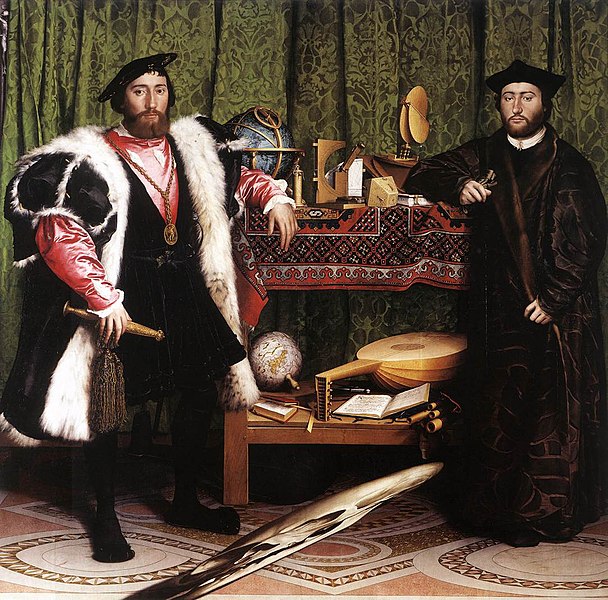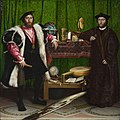Fitxer:Holbein-ambassadors.jpg

Fitxer original (1.084 × 1.069 píxels, mida del fitxer: 182 Ko, tipus MIME: image/jpeg)
| Aquest fitxer i la informació mostrada a continuació provenen del dipòsit multimèdia lliure Wikimedia Commons. |
Resum
| Hans Holbein el Jove: Els ambaixadors
|
|||||||||||||||||||||||||||
|---|---|---|---|---|---|---|---|---|---|---|---|---|---|---|---|---|---|---|---|---|---|---|---|---|---|---|---|
| Artista |
artist QS:P170,Q48319 |
||||||||||||||||||||||||||
| Títol |
Jean de Dinteville i Georges de Selve. Altres títols: |
||||||||||||||||||||||||||
| Object type |
pintura |
||||||||||||||||||||||||||
| Gènere |
retrat |
||||||||||||||||||||||||||
| Descripció |
Holbein painted this work in the early part of his second stay in England, which began in 1532. At this time he was prolific, painting Hanseatic merchants, courtiers, landowners, and visitors. The Ambassadors is his most famous and perhaps greatest painting of this period. The life-sized panel portrays Jean de Dinteville, an ambassador of Francis I of France in 1533, and Georges de Selve, Bishop of Lavaur, who visited London the same year. Until the publication of Mary F. S. Hervey's Holbein's Ambassadors: The Picture and the Men in 1900, the identity of the two figures in the picture had been a matter of intense debate. In 1890, Sidney Colvin was the first to propose the figure on the left as Jean de Dinteville, Seigneur of Polisy (1504–1555), French ambassador to the court of Henry VIII for most of 1533. Shortly afterwards, the cleaning of the picture revealed his seat of Polisy as one of only four places marked on the globe. Hervey identified the man on the right as Georges de Selve (1508/09–1541), Bishop of Lavaur, after tracing the painting's history back to a 17th-century manuscript. Hervey's identification of the sitters has remained the standard one, affirmed in several extended studies of the painting. However, rival speculation is not entirely dead. Opposition to the identification of de Selve has been based on an inventory of 1589, discovered by Riccardo Famiglietti, which names the man on the right as de Dinteville's brother François. Leading scholars of the painting argue that this identification of 1589 was incorrect. |
||||||||||||||||||||||||||
| Persones retratades | |||||||||||||||||||||||||||
| Data |
1533 date QS:P571,+1533-00-00T00:00:00Z/9 |
||||||||||||||||||||||||||
| Material/Tècnica | oli i tremp sobre tauler de roure | ||||||||||||||||||||||||||
| Dimensions |
altura: 207 cm; amplada: 209 cm dimensions QS:P2048,207U174728 dimensions QS:P2049,209U174728 |
||||||||||||||||||||||||||
| Col·lecció |
institution QS:P195,Q180788 |
||||||||||||||||||||||||||
| Número d'inventari |
NG1314 |
||||||||||||||||||||||||||
| Lloc de creació |
Londres |
||||||||||||||||||||||||||
| Historial de l'obra |
1890: adquirit per the National Gallery, Londres |
||||||||||||||||||||||||||
| Inscripcions |
|
||||||||||||||||||||||||||
| Referències |
|
||||||||||||||||||||||||||
| Control d'autoritats | |||||||||||||||||||||||||||
| Origen/Fotògraf |
Web Gallery of Art: reference_wga QS:P973,"http://www.wga.hu/html/h/holbein/hans_y/1535a/1ambassa.html" |
||||||||||||||||||||||||||
| Altres versions |
|
||||||||||||||||||||||||||
|
Llicència
|
Això és una mera fotografia d'una obra d'art bidimensional en domini públic. L'obra d'art original és en domini públic pel següent motiu:
La posició oficial de la Fundació Wikimedia és que «les reproduccions fidels d'obres d'art bidimensionals de domini públic són en domini públic».
Per tant, aquesta reproducció fotogràfica també es considera en domini públic als Estats Units. En altres jurisdiccions la reutilització d'aquest contingut pot estar restringida; vegeu Reuse of PD-Art photographs per a més informació. | |||||
| Anotacions InfoField | Aquesta imatge té anotacions: Vegeu-les a Commons |
A skewed image of a skull can only be seen properly when the painting is viewed from the side.
"... 25" the age of the painter at that time
Llegendes
Elements representats en aquest fitxer
representa l'entitat
Historial del fitxer
Cliqueu una data/hora per veure el fitxer tal com era aleshores.
| Data/hora | Miniatura | Dimensions | Usuari/a | Comentari | |
|---|---|---|---|---|---|
| actual | 05:05, 16 feb 2011 |  | 1.084 × 1.069 (182 Ko) | Dcoetzee | Reverted to version as of 23:13, 3 December 2004; do not overwrite images with different images, I'll use CommonsDelinker to change the links |
| 04:29, 23 ago 2010 |  | 4.215 × 4.226 (2,73 Mo) | Helms | Higher quality update for most used file | |
| 00:13, 4 des 2004 |  | 1.084 × 1.069 (182 Ko) | Stw | The Ambassadors by Hans Holbein the Younger. {{PD-Art}} |
Ús del fitxer
No hi ha pàgines que utilitzin aquest fitxer.
Ús global del fitxer
Utilització d'aquest fitxer en altres wikis:
- Utilització a en.wikipedia.org
- User talk:Major Bonkers/Archive Oct 2007
- User talk:P. S. Burton/Archive 1
- Wikipedia:Featured picture candidates/The Ambassadors
- Wikipedia:Featured picture candidates/September-2010
- Wikipedia:Featured picture candidates/delist/2011
- Wikipedia:Featured picture candidates/delist/File:Holbein-ambassadors.jpg
- Utilització a es.wikipedia.org
- Utilització a fi.wikipedia.org
- Utilització a fr.wikipedia.org
- Utilització a fr.wikibooks.org
- Utilització a hu.wikipedia.org
- Utilització a www.wikidata.org
Metadades
Aquest fitxer conté informació addicional, probablement afegida per la càmera digital o l'escàner utilitzat per a crear-lo o digitalitzar-lo. Si s'ha modificat posteriorment, alguns detalls poden no reflectir les dades reals del fitxer modificat.
| Comentari del fitxer JPEG | HOLBEIN, Hans the Younger
(b. 1497, Augsburg, d. 1543, London) Jean de Dinteville and Georges de Selve (`The Ambassadors') 1533 Oil on oak, 207 x 209 cm National Gallery, London This huge panel is one of the earliest portraits combining two full-length figures on the scale of life. A paean to two scholar-diplomats and to the artist's virtuosity, it is on closer examination a reminder also of the brevity of life and of the vanity of human accomplishments. While life is short, Holbein seems to say, art is long-lasting - but eternity endures for ever. On our left stands Jean de Dinteville, a French nobleman posted to London as ambassador. The globe on the bottom shelf shows Polisy, where he had his château; the ornate sheath of the dagger in his right hand gives his age as 29. To his left stands his friend and fellow-countryman, Georges de Selve, whose visit to London in 1533 is commemorated here. A brilliant classical scholar, he had some years earlier been created Bishop of Lavaur. He leans his elbow on a book inscribed with his age: 25. In their attire, their poses and their bearing the two friends exemplify, respectively, the active and the contemplative life, which, together, complement each other. On the what-not between them Holbein has depicted the wide range of their interests - a compendium of the culture of the age. On the top shelf, the minutely rendered `Turkey' carpet bears a celestial globe and an array of astronomical and navigational instruments. The cylindrical dial gives the date as 11 April; the polyhedral dial on the right indicates two different times of day. In front of the terrestrial globe on the lower shelf lies a German text-book of Arithmetic for Merchants, propped open with a T-square. A lute and a case of recorders or flutes demonstrate both Holbein's mastery of foreshortening and the sitters' musical interests. But a string of the lute has snapped, a traditional emblem of fragility. Just visible in the top left corner, at the edge of the magnificently patterned green hanging, is a crucifix. The hymnal in front of the lute is open at Martin Luther's hymn,'Come Holy Ghost our souls inspire'. Christian faith offers hope of eternal life when dust returns to dust. Across the mosaic floor - derived from the medieval pavement in Westminster Abbey - there spreads a curious shape between the two friends. It is a skull, skilfully distorted so that its true form can only be perceived from the correct viewpoint at the edges of the panel. The painting may have been intended to hang over a staircase so that viewers might see it when ascending or descending. Possibly referring to a personal device of Jean de Dinteville, whose cap medallion bears a skull, it is also the quintessential memento mori, reminder of mortality. In Holbein's meticulously real-seeming picture, the distortion also functions as a signal that reality, as perceived by the senses, must be viewed `correctly' to reveal its full meaning. A frontal nod of recognition at the worldly semblance of things is not enough.
Author: HOLBEIN, Hans the Younger Title: Jean de Dinteville and Georges de Selve (`The Ambassadors') Time-line: 1501-1550 School: German Form: painting Type: portrait |
|---|






